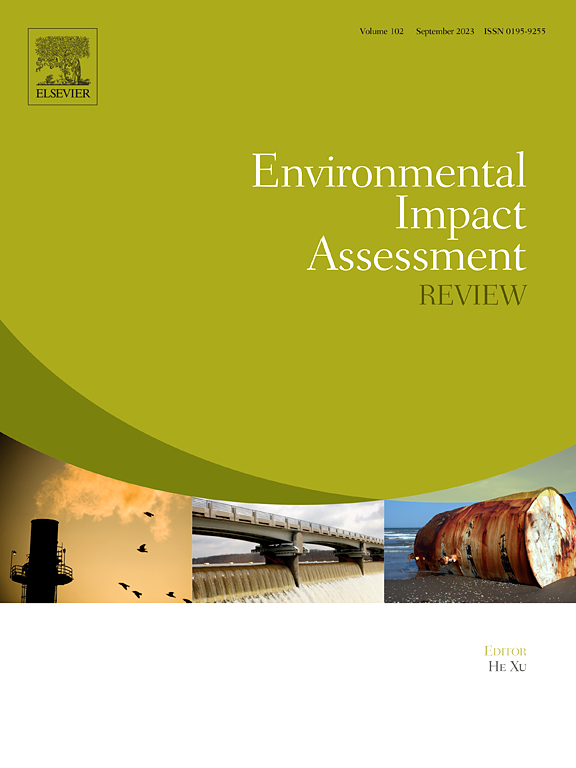Life cycle environmental assessment of state and national highways in India: Evaluating impact reduction potential of sustainable measures
IF 9.8
1区 社会学
Q1 ENVIRONMENTAL STUDIES
引用次数: 0
Abstract
The present study assessed the environmental impacts of State Highways (SH) and National Highways (NH) in India and assessed the potential for impacts reduction through sustainable interventions. This study is one of the first efforts to assess environmental impacts throughout the pavement life cycle in India along with the identification of sustainable measures. The life cycle impact analysis was performed using LCA for Experts software, with a functional unit of 1 km of road pavement, 7.0 m wide. The LCA was performed as per the ISO 14040, ISO 14044, and ISO 21931-2. The results revealed that NH exhibits higher impacts than SH, with flexible pavements having 20–61 % higher impacts and rigid pavements showing a 5–9 % increase. The use phase (50–67 %) dominated the impact of both flexible and rigid pavements, primarily due to street lighting and fuel consumption, followed by the materials extraction and construction phase (27–46 %) and the end-of-life phase (2–3 %). Improvement scenarios demonstrated significant impact reduction potential. The suggested measures showed impacts reduction potential ranging from 19 % to 152 % on different impact categories for flexible pavements. Similarly, for rigid pavements, the suggested measures were found to reduce impacts by 24 % to 44 %. The green highways with tree plantations will directly reduce 22 t of CO2/km/year. Furthermore, the green hydrogen vehicles achieved reductions of 48–152 % (flexible) and 44–73 % (rigid), while solar-powered electric vehicles yielded the highest benefits, with reductions of 59–160 % (flexible) and 49–83 % (rigid). The findings provide insights for transport planners and a policy for integrating sustainable materials and technologies to minimize the environmental impacts and promote sustainable road transportation.

印度州和国家公路的生命周期环境评估:评估可持续措施减少影响的潜力
本研究评估了印度国道(SH)和国道(NH)的环境影响,并评估了通过可持续干预措施减少影响的潜力。这项研究是评估印度整个路面生命周期对环境影响以及确定可持续措施的首批努力之一。使用LCA for Experts软件进行生命周期影响分析,功能单元为1 km的道路路面,7.0 m宽。LCA是按照ISO 14040、ISO 14044和ISO 21931-2进行的。结果表明,NH路面比SH路面的影响更大,其中柔性路面的影响比SH路面高20 - 61%,刚性路面的影响比SH路面高5 - 9%。使用阶段(50 - 67%)主导了柔性和刚性路面的影响,主要是由于街道照明和燃料消耗,其次是材料提取和施工阶段(27 - 46%)和寿命结束阶段(2 - 3%)。改进方案展示了显著减少影响的潜力。建议的措施显示,弹性路面在不同影响类别上的减少影响潜力由19%至152%不等。同样,对于刚性路面,建议的措施可以减少24%至44%的影响。绿化高速公路将直接减少22吨二氧化碳/公里/年。此外,绿色氢燃料汽车实现了48 - 152%(柔性)和44 - 73%(刚性)的减排,而太阳能电动汽车的减排效果最高,分别为59 - 160%(柔性)和49 - 83%(刚性)。研究结果为交通规划者提供了见解,并为整合可持续材料和技术以减少环境影响和促进可持续道路运输提供了政策。
本文章由计算机程序翻译,如有差异,请以英文原文为准。
求助全文
约1分钟内获得全文
求助全文
来源期刊

Environmental Impact Assessment Review
ENVIRONMENTAL STUDIES-
CiteScore
12.60
自引率
10.10%
发文量
200
审稿时长
33 days
期刊介绍:
Environmental Impact Assessment Review is an interdisciplinary journal that serves a global audience of practitioners, policymakers, and academics involved in assessing the environmental impact of policies, projects, processes, and products. The journal focuses on innovative theory and practice in environmental impact assessment (EIA). Papers are expected to present innovative ideas, be topical, and coherent. The journal emphasizes concepts, methods, techniques, approaches, and systems related to EIA theory and practice.
 求助内容:
求助内容: 应助结果提醒方式:
应助结果提醒方式:


